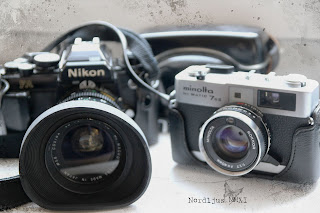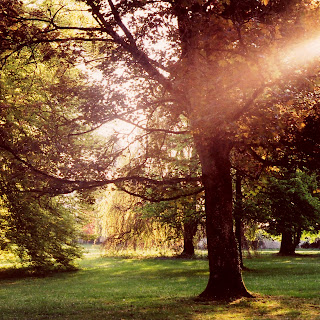In one of the simple soulful photography lessons, we were encouraged to try a different camera. A Polaroid camera was strongly suggested, and it's definitely something, I want to try out one day in the future. But I havent' got one. But what I found when tidying up over the weekend, was my parents, no mine, old Minolta Hi-Matic 7sII compact camera. It's in perfect condition, having been safely stored away in its beautiful leather case inside its original box for years. Together with the original manual, which is very handy :-). Also, the 7sII is said to at the top of the hi-matic range, and the lens, a Rokkor 1:1.4 40mm fixed lens, apparently is renowned for it's sharpness. Well, it all sounds good so far :).
I had wanted to shoot with film again for some time now, especially as I was given an old Nikon FA SLR about two years ago, complete with a whole range of lenses (and the manual :) ), but I'm not feeling ready yet to tackle that one. I've only started shooting in manual mode with my DSLR a few weeks ago, and I'm still learning how it all works together. Shutter speed, especially, is something I still find rather difficult.
 So the compact Minolta seems a good choice for the moment. I must admit, though, that haven't really got much of an idea yet how to properly use it (despite the manual). The great advantage of a digital camera is, of course, that you can see the exposure scale in your viewfinder and adapt shutter speed and/or aperture accordingly. And of course, you can see immediately on the display, if it's any good or not. The Minolta Hi-Matic 7sII also has an Automatic mode as well as the possibility of manual settings. When I looked for some information aobut the camera on the internet, it was mentioned that the automatic mode is actually not reliable anymore, as the batteries had a different voltage back then. But I decided to shoot in automatic mode anyway, at the beginning. So I bought battery and film and started shooting.
So the compact Minolta seems a good choice for the moment. I must admit, though, that haven't really got much of an idea yet how to properly use it (despite the manual). The great advantage of a digital camera is, of course, that you can see the exposure scale in your viewfinder and adapt shutter speed and/or aperture accordingly. And of course, you can see immediately on the display, if it's any good or not. The Minolta Hi-Matic 7sII also has an Automatic mode as well as the possibility of manual settings. When I looked for some information aobut the camera on the internet, it was mentioned that the automatic mode is actually not reliable anymore, as the batteries had a different voltage back then. But I decided to shoot in automatic mode anyway, at the beginning. So I bought battery and film and started shooting.
The day before yesterday, I took the roll to a camera shop to have it developped, and last night, I could pick them up. I really didn't know what to expect. I just hoped that there'd be one or two decent shots, and that it hadn't all been just a complete waste of money...
 I must say, I'm pleasently surprised with the result! I expected that most would be over- or underexposed and/or completely out of focus. Three or four were out of focus, but then I find the focussing rather difficult, because sometimes, I really just don't see it! And sometimes, I just simply forget about it, being used to my DSLR's autofocus... But apart from that, the exposure is allright with basically all of them, and they're really nice and sharp. The only great disadvantage were the costs. The prints, together with the developping, cost a small fortune, and to this add the cost of the film roll. Next time, I'll take them to my local supermarket, and maybe have them printed 9x13cm, instead of 10x15cm. Also, I wasn't sure whether to choose matt or glossy. I went for glossy, but somehow, I think that matt would suit the camera better, as would the 9x13 size.
I must say, I'm pleasently surprised with the result! I expected that most would be over- or underexposed and/or completely out of focus. Three or four were out of focus, but then I find the focussing rather difficult, because sometimes, I really just don't see it! And sometimes, I just simply forget about it, being used to my DSLR's autofocus... But apart from that, the exposure is allright with basically all of them, and they're really nice and sharp. The only great disadvantage were the costs. The prints, together with the developping, cost a small fortune, and to this add the cost of the film roll. Next time, I'll take them to my local supermarket, and maybe have them printed 9x13cm, instead of 10x15cm. Also, I wasn't sure whether to choose matt or glossy. I went for glossy, but somehow, I think that matt would suit the camera better, as would the 9x13 size.
Today, I tried to scan some of the photos to have a digital version. I don't kow if it's the scanner or the quality of the prints (which at that price should be good!), but the results were a disaster. The colours I can fix in PSE, no problem, but the sharpness... There's nothing left of the beautiful sharpness, instead, you can go cound pixels! Well, next time, I'll have a CD made along with the print, so I don't have to bother about turning them into a decen digital format... Somehow I didn't think about it at all! I'm so used to digital camera = digital files, film camera = prints.
But I'm happy so far, with my new (old) camera. It's fun to try out something different, and have other options along my beloved DSLR.
To sum up my experience, so far: |
| Think I took this in manual, with f/1.7, but I'm not quite sure |
The next thing I want to really learn is using it in manual. I've read about the Sunny 16 Rule, which says that on a bright, sunny day, use f/16 as aperture, and set shutter speed to the equivalent of your ISO film speed, i.e. with a ISO 100 film, set it to 1/125, with ISO 200 film to 1/250 etc. And if it's hazy sun, cloudy or overcast, basically do the same. This sounds all good enough, and certainly a thing to remember when doing landscape shots, for which f/16 works very well anyway, to make sure to get a good exposure. But what if you want to play with depth of field, and use an aperture of f1.7, for example? After all, if you have a lense that goes to f/1.7, you certainly want to use that, right? So what's the rule there?? I couldn't find anything, unfortunately, and I don't have any experience to fall back on. As I've mentioned before, shutter speed is the one thing I've rather avoided so far, always taking aperture as my starting point. Well, I think I'll just have to experiment, diligently making notes of everything, and learn by experience. And find a cheaper option for having the films developped...
But I'm happy so far, with my new (old) camera. It's fun to try out something different, and have other options along my beloved DSLR.
- It's easy enough to use and even though the battery voltage apparently apparently isn't right anymore, the automatic seems to works well enough
- I'm spared the white balance business, which often drives me mad with my DSLR
- But then, film means that you have to decide about the ISO beforehand
- More decisions: when you want to have prints, what size do you choose, and glossy or not?
- I love its compact size and solid quality. In its beautiful fitted leather case, I feel very comfortable to just throw it into my bag and carry it around all day. Not something I'd feel comfortable doing with my DSLR...
- I still have to figure out how to use it in manual mode (and start making notes about settings for each photo I take!)
 Take it to the local supermarket for development, rather than the very expensive camera shop (unless it's b&w film)
Take it to the local supermarket for development, rather than the very expensive camera shop (unless it's b&w film)- Have prints made in 9x13cm format, rather than 10x15cm, and maybe try out matt finish rather than glossy (seems to me to fit the period of the camera better)
- Rather than getting frustrated with trying to scan them, have a CD made along with the prints
- Get to know which subjects work best and which don't with this camera
- Always try to remember to focus properly! :)
- I really like the sound of the shutter and of forwarding the film
- Have / develop patience to learn how to use the camera to achieve best results, and practice, practice, practice :)




































